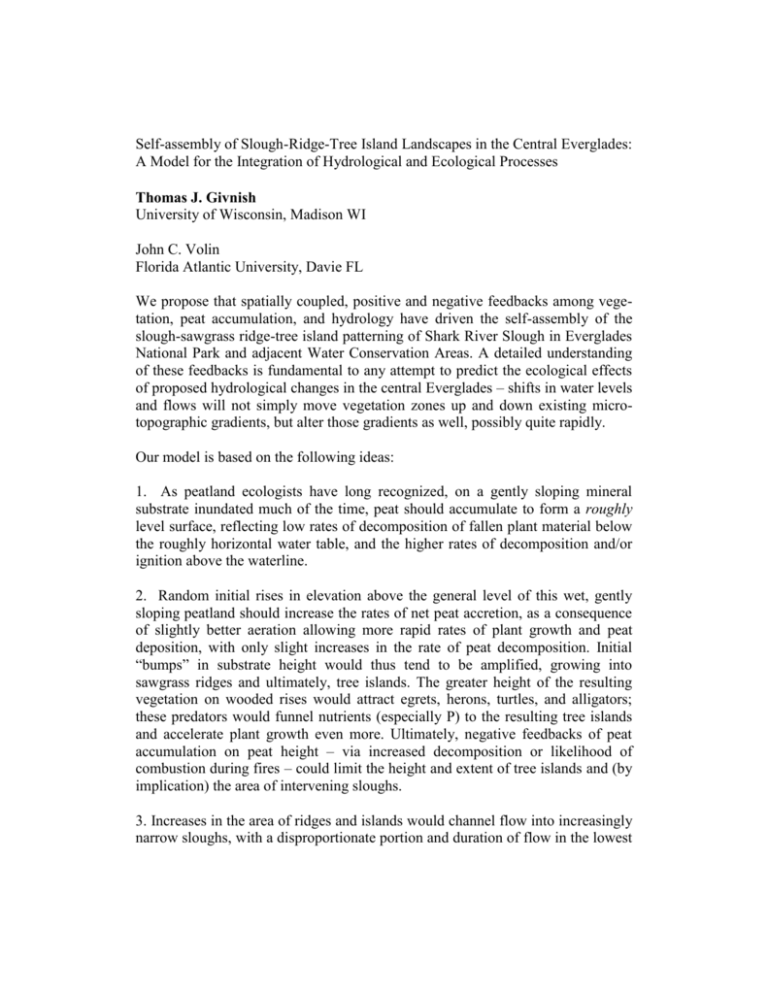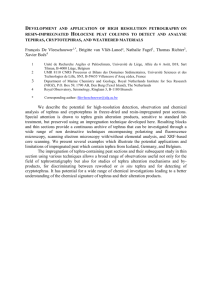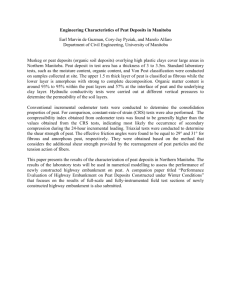Self-assembly of Slough-Ridge-Tree Island Landscapes in the
advertisement

Self-assembly of Slough-Ridge-Tree Island Landscapes in the Central Everglades: A Model for the Integration of Hydrological and Ecological Processes Thomas J. Givnish University of Wisconsin, Madison WI John C. Volin Florida Atlantic University, Davie FL We propose that spatially coupled, positive and negative feedbacks among vegetation, peat accumulation, and hydrology have driven the self-assembly of the slough-sawgrass ridge-tree island patterning of Shark River Slough in Everglades National Park and adjacent Water Conservation Areas. A detailed understanding of these feedbacks is fundamental to any attempt to predict the ecological effects of proposed hydrological changes in the central Everglades – shifts in water levels and flows will not simply move vegetation zones up and down existing microtopographic gradients, but alter those gradients as well, possibly quite rapidly. Our model is based on the following ideas: 1. As peatland ecologists have long recognized, on a gently sloping mineral substrate inundated much of the time, peat should accumulate to form a roughly level surface, reflecting low rates of decomposition of fallen plant material below the roughly horizontal water table, and the higher rates of decomposition and/or ignition above the waterline. 2. Random initial rises in elevation above the general level of this wet, gently sloping peatland should increase the rates of net peat accretion, as a consequence of slightly better aeration allowing more rapid rates of plant growth and peat deposition, with only slight increases in the rate of peat decomposition. Initial “bumps” in substrate height would thus tend to be amplified, growing into sawgrass ridges and ultimately, tree islands. The greater height of the resulting vegetation on wooded rises would attract egrets, herons, turtles, and alligators; these predators would funnel nutrients (especially P) to the resulting tree islands and accelerate plant growth even more. Ultimately, negative feedbacks of peat accumulation on peat height – via increased decomposition or likelihood of combustion during fires – could limit the height and extent of tree islands and (by implication) the area of intervening sloughs. 3. Increases in the area of ridges and islands would channel flow into increasingly narrow sloughs, with a disproportionate portion and duration of flow in the lowest portions of the sloughs. The presence of high water in sloughs would tend to maintain them and prevent them from occupying too small a proportion of the landscape, by restricting plant production and hence peat deposition. The low density of sedge/waterlily peat may also allow more groundwater flow through the sloughs. Flow is essential for this set of feedbacks to operate and maintain the sloughs: on a level substrate, one might expect all sites to become “bumps” and generate a level landscape overall. Flow could maintain a slough-ridge-tree island microtopography in the absence of any erosive processes. 4. As a consequence of the spatially coupled feedbacks operating on sloughs vs. ridges and tree islands, we expect that peat accretion rate (H) should rise, then fall with peat height (H) relative to mean water-table height. This non-linear relationship of peat growth rate to peat height should reflect differing, non-linear relationships of the rates of plant production and peat decomposition along the slough-tree island gradient; it would tend to amplify incipient ridges and deepen incipient sloughs, and lead to self-assembly of a patterned peatland. Drainage would tend to produce parallel sloughs running straight downslope; groundwater transport of nutrients accumulating on ridges and islands should tend to elongate them downslope as well, producing tails. The streamlining of tree islands can arise not from erosion, but simply as a self-organizing pattern that minimizes mixing across boundaries between areas with different nutrient supply rates that set, in part, different peat accretion rates. 5. We propose that specific, previously overlooked differences between cationpoor boreal peatlands and the cation-rich, P-poor Everglades are responsible for the striking differences in horizontal patterning that these ecosystems display. It is simply not possible to account for patterning parallel to flow in the Everglades based on the mechanisms that produce patterning perpendicular to flow (e.g., strings, flarks) in boreal peatlands. 6. Other feedbacks might modulate the expected relationship of H vs. H. Fires spreading through sawgrass may be less likely to spread into (and perhaps burn the substrate of) tree islands, in which shading by tall woody plants eliminates most of the highly flammable graminoids from the understory. Waterlilies may also create an important additional feedback enlarging or maintaining the sloughs. Such plants are favored by deeper water and may themselves creater deeper water – they have internal winds in their petiolar aerenchyma that literally blow oxygen to their roots and rhizomes, some of which diffuses into the surrounding substrate and should thus increase the local rate of peat decomposition. We and our colleagues have now begun to test several aspects of this model, using stratigraphic data and measurements of present-day production and decomposition along gradients of microtopography, soil depth, and flow speeds in different portions of the central Everglades that have had radically different flow regimes and water-control policies over the past several decades. Our aim is to integrate our findings with data on the present-day distributions of different vegetational bands and a model for landscape-sacle sheetflow to ask how proposed changes in water-control policy might affect the resulting mosaic of vegetation, landforms, and hydroregimes. In the longer term, we would like to determine whether H vs. H feedback varies as we expect along the length of the Everglades. Spatially coupled, positive and negative feedbacks may be the most important determinants of hydrology, substrate, and vegetation in the central Everglades. Models that assume substrate elevations and permeabilities as given – rather than as part of a dynamic peatland ecosystem in which hydrology, substrate, and vegetation all have strong feedbacks on each other – are ecologically simplistic. Adopting a more dynamic view may help explain why the Everglades are so flat despite substantial variation in the height of the underlying bedrock; why the vegetated landscape is streamlined into sloughs and ridges, and dependent on water flow; why tree islands can have little connection to fluctuations in depth to the rocky substrate; why there may be substantial dynamism in the horizontal position of sloughs and ridges; and why there may be striking regularities in the spacing of islands and ridges.









